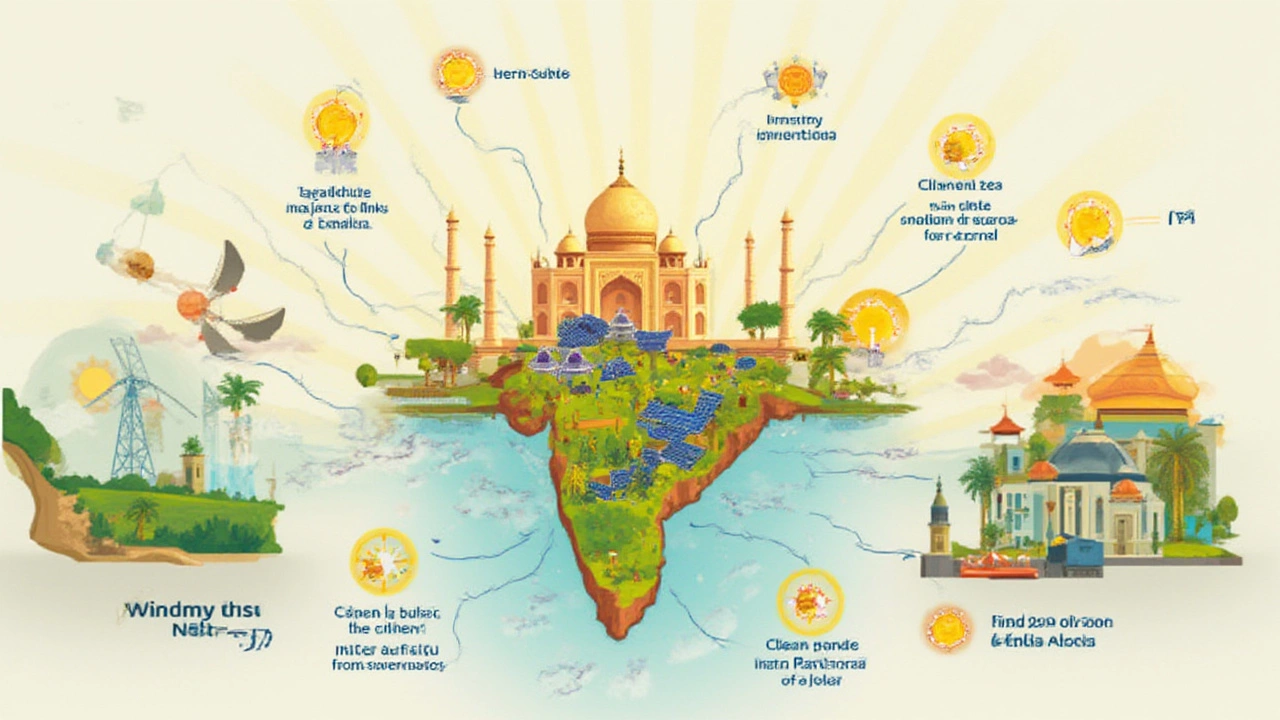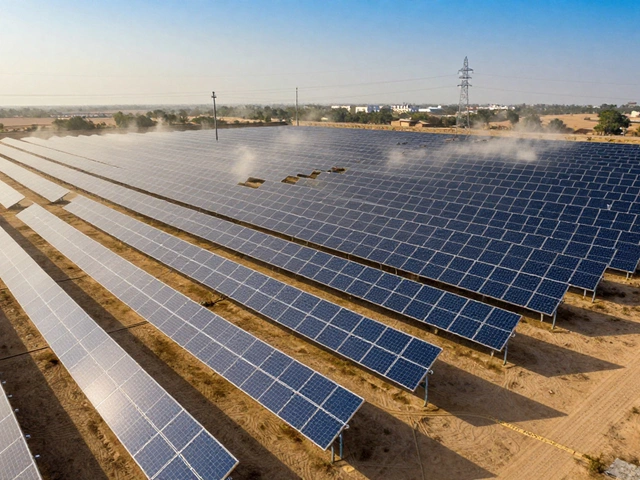If I told you the sun delivers more energy to Earth in one hour than the entire planet uses in a year, would you believe it? It sounds wild, but that’s actually true. We’re living in a time when our appetite for electricity keeps growing, and old-school methods of burning fossil fuels just aren’t cutting it anymore. Air quality drops, costs go up, and let's be honest—no one wants those rolling blackouts. The search for an energy source that's clean, reliable, and affordable has led us to one answer above all others: solar power. If you look at the facts, nothing else even comes close. Solar isn’t just having a moment—it’s changing the way the world thinks about energy for good.
The Bright Side: Why Solar Takes the Top Spot
So, why is solar power crowned the number one renewable energy? It’s simple: sunlight is free, solar technology is getting insanely efficient, and just about anyone with a rooftop can take part. To see how solar stacks up, let’s break down its main advantages against other renewable contenders like wind, hydro, and biomass.
First off, the scale is mind-blowing. The International Energy Agency (IEA) reported in 2023 that solar power made up over 70% of new renewable energy capacity installed worldwide. China, the US, and India are leading the way, but solar panels are popping up everywhere from villages in Africa to skyscrapers in Singapore. The tech itself is super accessible—a typical solar panel is now 85% cheaper than it was in 2010, according to BloombergNEF. This price drop isn’t just about making it easier for rich countries to go green, either. It means solar lanterns for remote clinics, and farmers powering water pumps straight from the sun.
The maintenance side? Almost worry-free compared to other methods. Wind turbines need constant checking (they’re complicated machines with a lot of moving parts), and hydropower has huge upfront costs plus nasty environmental trade-offs like flooding habitats. Once you put in solar panels, they just sit there quietly doing their job for 20 years or more. And since India gets around 250–300 sunny days every year, solar is a no-brainer for my own backyard. This isn’t just my opinion. Fatih Birol, the executive director at IEA, was quoted saying:
“I see solar becoming the new king of the world’s electricity markets.”
It’s not just about cutting your electricity bills, either. Solar power creates jobs—lots of them. According to the International Renewable Energy Agency (IRENA), the global solar workforce hit over 4 million people in 2022, outpacing wind and hydro jobs combined. These are jobs in manufacturing, installation, sales, and maintenance—meaning everything from factory work in Bangalore to rooftop installations in Berlin. Not bad for something driven by the same sunlight we all take for granted.
Take a look at how solar measures up against other renewables based on key metrics:
| Energy Source | Startup Cost (USD per kW) | Avg. Efficiency | Lifespan (years) | Global Installed Capacity (2024, GW) |
|---|---|---|---|---|
| Solar PV | ~$950 | 15-23% | 25-30 | 1460 |
| Wind | ~$1,300 | 30-45% | 20-25 | 1000 |
| Hydropower | ~$2,000 | 35-45% | 50-100 | 1200 |
| Biomass | ~$2,200 | 20-25% | 20-25 | 150 |
The startup cost for solar is among the lowest, and with constant advances in panel tech, that efficiency number keeps creeping up each year. And when you factor in zero fuel costs and almost no moving parts to break down, it’s clear why so many people are banking on solar to power the future.

Behind the Panels: Real-World Impact and Tech Innovations
So much for the big picture—what about the nuts and bolts? Solar power isn’t just a huge technology story; it’s completely reshaping communities and economies on the ground. I can walk around my neighborhood in Bangalore and spot solar water heaters and rooftop panels everywhere. Each panel quietly lowers electric bills and brings home energy independence. That’s just the start.
For millions, especially in rural or off-grid areas, solar means the difference between darkness and light—literally. Take the Saharsa district in Bihar, for example. Solar microgrids there have powered up dozens of villages where grid electricity still can’t reach. These setups mean school kids can study after sunset, clinics keep vaccines cold, and businesses can stay open. Some of these setups don’t look fancy—just a cluster of panels, some batteries, and LED lights—but the transformation is massive.
Tech progress is moving at insane speed, too. Perovskite solar cells, for example, promise double the efficiency of traditional silicon panels and can even be printed like newspaper. Solar panels can work on cloudy days; the myth that you need endless blazing sunshine is being put to rest. Even cities with less sun, like London or Tokyo, are turning rooftops into power stations.
Solar integration is upgrading how we live and travel. Rooftop panels keep germinating everywhere, but now solar glass windows, parking lot canopies, and floating "solar farms" on lakes are popping up. Heck, we even have solar-powered tuk-tuks hauling commuters in India. Storage solutions—think batteries like Tesla’s Powerwall and India’s own Ampere Energy setups—make solar power last all night, not just until sunset.
Check this out: in 2024, the world produced over 1600 TWh (terawatt hours) from solar, beating most experts’ predictions. India alone hit a record by installing over 15 GW of new solar capacity last year—a number that looked impossible a decade ago. Meanwhile, the price of solar batteries keeps falling, clearing the last barrier for 24/7 solar lifestyles.
Want tips on squeezing more juice from solar at home?
- Install panels on south-facing roofs—they soak up the most sunlight.
- Wipe the dust off regularly. Even a thin layer can cut output by 10% or more (and if you’re in a city, trust me—dust adds up fast).
- If you’re building, go big with efficient appliances and LED lighting. Every unit you save means less power you need to make.
- Don’t skimp on quality. Good panels cost a little more but are worth it for extra years (and usually better warranties).
And if you’re worried about the upfront cost—loads of places, including many Indian states, offer big subsidies or easy loans for rooftop solar. In 2025, Bangalore city even offered zero-interest EMIs for small home setups. People are catching on fast: it’s an investment that pays steady returns for decades.

The Future of Clean Energy: Where Solar Goes Next
If you think solar has hit its limit, think again. The next decade is set to bring a tidal wave of breakthroughs and applications. Forget about clunky rectangles on roofs—imagine flexible solar sheets that roll out on tents, highways, or even your backpack. Researchers at MIT unveiled a solar fabric in 2024 that can generate enough power for laptops and phones, and it weighs almost nothing. You’ll see solar tech blending into everything: car roofs, boats, phone cases, streetlights. Even agriculture is changing with "agrivoltaics"—using land for crops and solar panels at the same time—helping farmers protect fields from drought and heat while making energy.
And storage is finally catching up. New breeds of lithium-iron and sodium-ion batteries are making it practical (and cheap) to keep the lights on all night from solar alone, far beyond what we could dream up back in the 2000s. Utility-scale battery plants are springing up. In Gujarat, a giant solar-powered battery farm is backing up entire neighborhoods. This moves us closer to grids that don’t need coal or gas running in the background "just in case." The era of "duck curves" — when solar drops out at sunset — is coming to an end.
Even big business is all in. Google, Apple, Infosys, and other tech giants are now pledging 100% renewable energy, almost all via solar by 2030. That’s direct investment, not PR fluff. When the world’s largest companies are riding the solar wave, you can be pretty sure it’s not a fad.
Of course, nothing is perfect. Recycling old solar panels, managing land use, and clearing red tape are still headaches. But compared to the pollution, health costs, and political fistfights that come with fossil fuels—or the disruptions of giant dams—solar’s got fewer downsides. The more we build, the smarter and cheaper it gets.
Let’s face it—our energy future isn’t about picking one winner, but right now, solar is out in front and pulling away from the field. If you’ve got a patch of sun, a dream to save money, or a mission to make things cleaner, solar’s got your back. And next time you see those glossy blue panels on a roof, know this: you’re looking at the world’s #1 source of renewable power, lighting up lives and changing how we think about energy, one photon at a time.


